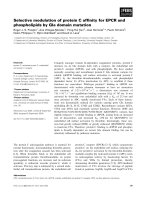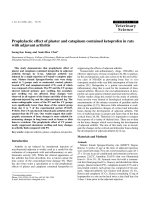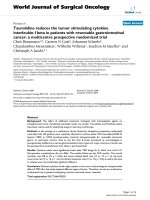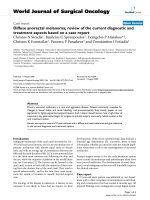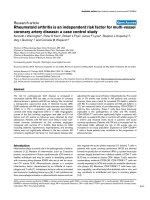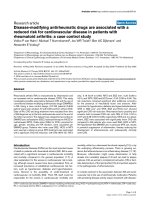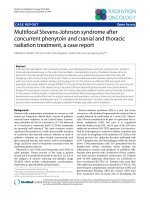Báo cáo khoa học: "Recombinant human activated protein C resets thrombin generation in patients with severe sepsis – a case control study" pot
Bạn đang xem bản rút gọn của tài liệu. Xem và tải ngay bản đầy đủ của tài liệu tại đây (306.98 KB, 8 trang )
Open Access
Available online />R490
Vol 9 No 5
Research
Recombinant human activated protein C resets thrombin
generation in patients with severe sepsis – a case control study
Anne-Cornélie JM de Pont
1
, Kamran Bakhtiari
2
, Barbara A Hutten
3
, Evert de Jonge
1
,
Margreeth B Vroom
4
, Joost CM Meijers
5
, Harry R Büller
6
and Marcel Levi
7
1
Intensivist, Department of Intensive Care, Academic Medical Center, University of Amsterdam, The Netherlands
2
Laboratory Researcher, Department of Vascular Medicine, Academic Medical Center, University of Amsterdam, The Netherlands
3
Clinical Epidemiologist, Department of Epidemiology and Biostatistics, Academic Medical Center, University of Amsterdam, The Netherlands
4
Professor of Intensive Care Medicine, Department of Intensive Care, Academic Medical Center, University of Amsterdam, The Netherlands
5
Head of the Laboratory of Vascular Medicine, Department of Vascular Medicine, Academic Medical Center, University of Amsterdam, The
Netherlands
6
Professor of Vascular Medicine, Department of Vascular Medicine, Academic Medical Center, University of Amsterdam, The Netherlands
7
Professor of Internal Medicine, Department of Internal Medicine, Academic Medical Center, University of Amsterdam, The Netherlands
Corresponding author: Anne-Cornélie JM de Pont,
Received: 24 Apr 2005 Revisions requested: 3 Jun 2005 Revisions received: 24 Jun 2005 Accepted: 28 Jun 2005 Published: 21 Jul 2005
Critical Care 2005, 9:R490-R497 (DOI 10.1186/cc3774)
This article is online at: />© 2005 de Pont et al.; licensee BioMed Central Ltd.
This is an Open Access article distributed under the terms of the Creative Commons Attribution License ( />2.0), which permits unrestricted use, distribution, and reproduction in any medium, provided the original work is properly cited.
Abstract
Introduction Recombinant human activated protein C (rhAPC)
is the first drug for which a reduction of mortality in severe sepsis
has been demonstrated. However, the mechanism by which this
reduction in mortality is achieved is still not clearly defined. The
aim of the present study was to evaluate the dynamics of the
anticoagulant, anti-inflammatory and pro-fibrinolytic action of
rhAPC in patients with severe sepsis, by comparing rhAPC-
treated patients with case controls.
Methods In this prospectively designed multicenter case
control study, 12 patients who were participating in the
ENHANCE study, an open-label study of rhAPC in severe
sepsis, were treated intravenously with rhAPC at a constant rate
of 24 µg/kg/h for a total of 96 h. Twelve controls with severe
sepsis matching the inclusion criteria received standard therapy.
The treatment was started within 48 h after the onset of organ
failure. Blood samples were taken before the start of the infusion
and at 4, 8, 24, 48, 96 and 168 h, for determination of
parameters of coagulation and inflammation.
Results Sepsis-induced thrombin generation as measured by
thrombin-antithrombin complexes and prothrombin fragment
F1+2, was reset by rhAPC within the first 8 h of infusion. The
administration of rhAPC did not influence parameters of
fibrinolysis and inflammation. There was no difference in
outcome or occurrence of serious adverse events between the
treatment group and the control group.
Conclusion Sepsis-induced thrombin generation in severely
septic patients is reset by rhAPC within the first 8 h of infusion
without influencing parameters of fibrinolysis and inflammation.
Introduction
During severe sepsis, activation of the inflammatory cascade
leads to cell damage and organ failure. In recent years, the
importance of the cross-talk between coagulation and inflam-
mation in severe sepsis has been well defined. This has led to
the hypothesis that inhibitors of coagulation might have a dual
effect, that is, interruption of the cascades of both coagulation
and inflammation. Recombinant human activated protein C
(rhAPC, drotrecogin alfa (activated), Xigris
®
) is the first drug
for which a reduction of mortality in severe sepsis has been
APC = activated protein C; APTT = activated partial thromboplastin time; COPD = chronic obstructive pulmonary disease; EDTA = ethylene diamine
tetraacetic acid; ELISA = enzyme-linked immunosorbent assay; ENHANCE = extended evaluation of recombinant activated protein C; EPCR =
endothelial protein C receptor; F1+2 = prothrombin fragment F1+2; ICU = intensive care unit; IL = interleukin; NS = not significant; PAI-1 = plas-
minogen activator inhibitor type 1; PAP = plasmin-antiplasmin complexes; PAR-1 = protease activated receptor type 1; PCI = protein C inhibitor;
PROWESS = protein C worldwide evaluation in severe sepsis; PT = prothrombin time; rhAPC = recombinant human activated protein C; SD = stand-
ard deviation; SOFA = sepsis-related organ failure assessment ; TAFI = thrombin-activatable fibrinolysis inhibitor; TAT = thrombin-antithrombin com-
plexes; TNF = tumor necrosis factor.
Critical Care Vol 9 No 5 de Pont et al.
R491
demonstrated [1]. Indeed, rhAPC is an effective anticoagulant
and also has distinct anti-inflammatory effects, at least in vitro.
However, the mechanism by which the reduction in mortality
by rhAPC is achieved is still not clearly defined. Several mech-
anisms have been proposed. Firstly, rhAPC may inhibit the for-
mation of thrombin by proteolytically degrading coagulation
factors Va and VIIIa. Thrombin has a central role in coagulation
due to its ability to convert fibrinogen to fibrin, but also as the
most potent agonist of platelet activation [2]. Thrombin may
also affect the production of inflammatory cytokines by binding
to protease-activated receptors (PARs) in mononuclear cells
[3]. Secondly, rhAPC may inhibit the action of plasminogen
activator inhibitor type I (PAI-I), thereby restoring the sup-
pressed fibrinolytic state during sepsis [4]. Thirdly, binding of
rhAPC to the endothelial protein C receptor (EPCR) may influ-
ence gene expression profiles of cells by blocking nuclear fac-
tor kappa B nuclear translocation, which is required for
increases in proinflammatory cytokines and adhesion mole-
cules [5]. Direct activation of PAR-1 by the APC-EPCR com-
plex is another mechanism by which APC may affect
inflammation [6]. Fourthly, it is hypothesized that rhAPC inhib-
its the adherence of activated leukocytes to activated
endothelium [5,7]. However, the relative importance of each of
these mechanisms for the mortality reduction in severe sepsis
by rhAPC is still unclear.
The aim of the current study was to evaluate the dynamics of
the anticoagulant, anti-inflammatory and pro-fibrinolytic action
of rhAPC in patients with severe sepsis, by comparing rhAPC-
treated patients with case controls. For this purpose, we
employed sensitive assays for the assessment of activation
and inhibition of the coagulant, inflammatory and fibrinolytic
system.
Methods
Study design
The ENHANCE study, an open-label study of rhAPC in severe
sepsis, was conducted worldwide and more than 2000
patients were included. In the Netherlands, four sites partici-
pated in the current ENHANCE substudy, three academic
hospitals and one large teaching hospital. After completion of
the ENHANCE study, an equal number of patients with severe
sepsis meeting identical inclusion criteria were prospectively
enrolled in this substudy to serve as case controls. At the time
of performance of the study, rhAPC was not yet licensed and
available for routine treatment of patients with severe sepsis.
Patients
The study was approved by the institutional review board and
written informed consent was obtained from all participants or
their authorized representatives. Patients were eligible for the
trial if they had a known or suspected infection, three or more
signs of systemic inflammation and a sepsis-induced dysfunc-
tion of at least one organ system that lasted no longer than 48
h. In patients enrolled in the ENHANCE study, treatment with
rhAPC was started within 48 h after they met the inclusion cri-
teria. The time of starting the rhAPC infusion was considered
as t = 0. In the controls, the time at which rhAPC would have
been started if the patient had been in the treatment group,
was considered as t = 0. Blood samples were taken at the
same time points in both the treatment group and the control
group.
Treatment
In the treatment group, rhAPC was administered intravenously
at a constant rate of 24 µg/kg body weight per hour for a total
duration of 96 h. The infusion was interrupted for 1 h before
any percutaneous procedure and was resumed 1 h later. Dur-
ing the infusion of rhAPC, no other anticoagulant was admin-
istered except nadroparin or dalteparin in a prophylactic dose.
Except for the administration of rhAPC, the treatment of
patients in both groups was identical.
Blood collection
Platelet counts were routinely determined daily. Blood for the
analysis of parameters of coagulation and inflammation was
collected from an arterial line just before t = 0 and at 4, 8, 24,
48, 96 and 168 h. Blood for platelet counts and cytokine
assays was collected in K3-EDTA-containing tubes. All other
blood samples were collected in citrated vacutainer tubes.
Plasma was prepared by centrifugation of blood at 2500 × g
twice for 20 mins at 16°C, followed by storage at -80°C until
assays were performed.
Laboratory assays
The plasma concentrations of thrombin-antithrombin com-
plexes (TAT), prothrombin fragment F1+2 (F1+2), and plas-
min-antiplasmin complexes (PAP) were measured by ELISA
(Dade Behring, Marburg, Germany). Activated partial throm-
boplastin time (APTT) and prothrombin time (PT) were per-
formed on an automated coagulation analyzer (Behring
Coagulation System, BCS) with reagents and protocols from
Figure 1
Levels of TAT and F1+2Levels of TAT and F1+2. Plasma levels of (a) TAT and (b) F1+2 in the
rhAPC group (▲) and the control group (❍). Data represent mean ±
SD. F1+2, prothrombin fragment F1+2; rhAPC, recombinant human
activated protein C; TAT, thrombin-antithrombin complexes.
Available online />R492
the manufacturer (Dade Behring). Protein C was determined
using the Coamatic protein C activity kit from Chromogenix
(Milan, Italy). Total protein S antigen was assayed by ELISA
using antibodies from DAKO (Glostrup, Denmark). Protein C
and S deficiencies were defined as activity levels of <65% of
the level measured in normal pool plasma. Free protein S was
measured by precipitating the C4b-binding protein-bound
fraction with polyethylene glycol 8000 and measuring the con-
centration of free protein S in the supernatant. Free protein S
deficiency was defined as an activity of <26% of the total pro-
tein S level. Protein C inhibitor (PCI) was determined by ELISA
as described by Elisen et al. [8]. Normal PCI levels vary from
55 to 142% of the PCI level measured in normal pool plasma.
Thrombin-activatable fibrinolysis inhibitor (TAFI) antigen levels
were assayed by ELISA as described by Mosnier et al. [9].
Normal TAFI levels vary from 50 to 150% of the TAFI level
measured in normal pool plasma. D-dimers were assayed with
an ELISA (Asserachrom D-Dimer, Roche, Almere, the
Netherlands). Platelet counts were assessed by a Cell-dyn
4000 analyzer (Abbott Laboratories, Abbott Park, IL, USA).
Tumor necrosis factor alpha (TNF-alpha), interleukin (IL)-6,
and IL-10 were measured using commercial ELISA kits (Cen-
tral Laboratory of the Netherlands Red Cross Blood Transfu-
sion Service, Amsterdam, the Netherlands). The assay
detection limits were 3 pg/ml for TNF-alpha, 0.6 pg/ml for IL-6
and 1.2 pg/ml for IL-10. All assays were performed by the Lab-
Table 1
Baseline characteristics of the patients
Characteristic rhAPC group (n = 12) Control group (n = 12)
Age, years 57 ± 16 66 ± 14
Male sex (%) 7 (58) 7 (58)
Pre-existing conditions, n 716
Malignancy 2 7
Diabetes 1 3
Hypertension 2 2
COPD 1 2
Myocardial infarction 0 1
Pancreatitis 1 1
Recent surgery (%) 3 (25) 3 (25)
APACHE II score 21 ± 6 22 ± 6
Mechanical ventilation 12 11
Shock 12 12
Vasopressor use 11 11
Renal replacement therapy 4 4
Number of dysfunctional organ systems 4 ± 1 3 ± 1
SOFA score at inclusion 10 ± 3 9 ± 2
Site of infection, n
Lung 8 8
Urinary tract 2 0
Other 2 4
Causes of infection, n
Gram positive 6 4
Gram negative 7 5
Anaerobes 0 1
Fungi 1 2
Data represent mean ± SD. APACHE, Acute Physiology and Chronic Health Evaluation; COPD, chronic obstructive pulmonary disease; SOFA,
sepsis-related organ failure assessment.
Critical Care Vol 9 No 5 de Pont et al.
R493
oratory for Clinical Chemistry, Hematology and Transfusion
and the Laboratory of Experimental Vascular Medicine at the
Academic Medical Center Amsterdam, the Netherlands.
Evaluation of patients
Patients were followed for 28 days after enrollment or until
death. Baseline characteristics were assessed within 24 h
prior to enrollment. Microbiologic culture results were
assessed daily from enrollment through day 28.
Statistical analysis
Data were analyzed using SPSS for Windows, v11.0 (SPSS
Inc, Chicago, IL, USA). Differences between the treatment
group and the case control group were tested by analysis of
repeated measures using mixed linear models. Changes in
time within the same group were analyzed by 1-way analysis of
variance. Values are given as means ± SD. Significance was
defined as p < 0.05.
Results
Patient characteristics
During the ENHANCE study, 12 patients were enrolled in the
substudy at the four participating sites. Another 12 patients
with severe sepsis were enrolled prospectively as case con-
trols at two of the four participating sites. The baseline charac-
teristics of the two patient groups are shown in Table 1. There
were more patients with malignancy in the control group, but
all other baseline characteristics were similar. The lung was
the most common site of infection in both groups and Gram-
negative infections were most common. The time elapsed
between meeting the inclusion criteria and t = 0 was 12.3 ±
13.2 h in the rhAPC group versus 26.7 ± 12.5 h in the control
group (p = 0.01).
Thrombin generation
Administration of rhAPC resulted in a reduction of sepsis-
induced thrombin generation, as reflected by a decrease in the
levels of TAT and F1+2 to 45 and 30% below baseline,
respectively, within 8 h, without a significant change for the
remaining 7 days (Fig. 1). In the control group, TAT and F1+2
levels increased to 2 and 1.4 times baseline, respectively,
within 4 days. The difference in F1+2 levels between the two
groups reached significance after 8 h (p = 0.03) and remained
significant for the remaining 7 days (p = 0.03). In the rhAPC
group, the APTT rose to a maximum of 1.4 times baseline
within 4 h after the start of the infusion (p = 0.004), whereas
the APTT remained stable in the control group. In both treat-
ment groups, the PT decreased over time. However, this
decrease only reached statistical significance in the control
group on day 4 and day 7 (data not shown).
Protein C pathway
Ninety-two percent of all patients were protein C deficient at
baseline, with mean protein C levels of 44 ± 20% in the rhAPC
group and 47 ± 12% in the control group (NS). As shown in
Fig. 2, protein C levels normalized in the course of 2 days in
both treatment groups. All patients were deficient in protein C
inhibitor with mean levels of 16 ± 13% in the rhAPC group and
21 ± 11% in the control group (NS). The levels of protein C
inhibitor more than doubled over time in both groups (p =
0.004). The increase was more pronounced in the control
group, but the difference between groups did not reach statis-
tical significance (Fig. 2).
At baseline, deficiency in total and free protein S was present
in 63 and 79% of all patients, respectively. Mean total and free
protein S levels in the rhAPC group were 53 ± 17% and 19 ±
7%, respectively, and in the control group 60 ± 20% and 19
± 10%, respectively (NS). The levels of total and free protein
S normalized in the course of 2 and 4 days, respectively (Fig.
3).
Figure 2
Levels of protein C and protein C inhibitorLevels of protein C and protein C inhibitor. Plasma levels of (a) protein
C and (b) protein C inhibitor in the rhAPC group (▲) and the control
group (❍). The levels of protein C and protein C inhibitor are expressed
as the percentage of the level measured in normal pool plasma. Data
represent mean ± SD. rhAPC, recombinant human activated protein C.
Figure 3
Levels of total and free protein SLevels of total and free protein S. Plasma levels of (a) total protein S
and (b) free protein S in the rhAPC group (▲) and the control group
(❍). The levels of total protein S are expressed as the percentage of the
level measured in normal pool plasma. The levels of free protein S are
expressed as a percentage of total protein S. Data represent mean ±
SD. rhAPC, recombinant human activated protein C.
Available online />R494
Platelet counts
Baseline platelet counts were 173 ± 121 × 10
9
/l in the rhAPC
group and 156 ± 85 × 10
9
/l in the control group (NS). In the
rhAPC group, there was a trend toward an increase in platelet
count: platelets increased from 173 ± 121 to 270 ± 190 ×
10
9
/l on day 6 (p = 0.06). In the control group, the platelet
count increased from 156 ± 85 to 202 ± 189 × 10
9
/l on day
6 (p = 0.44). The difference between the two groups was too
small to reach statistical significance.
Fibrinolysis
Parameters of fibrinolysis are shown in Fig. 4. Baseline D-
dimer levels did not differ significantly between groups and did
not change significantly over time. PAP levels tended to
increase in the rhAPC group, whereas they remained stable in
the control group. However, the difference between groups
was too small to reach statistical significance. In both groups,
TAFI levels were depressed at baseline (56 ± 26% in the
rhAPC group and 64 ± 16% in the control group), returning to
normal in the course of 4 days, without a significant difference
between groups.
Cytokines
The time course of cytokine levels is depicted in Fig. 5. Levels
of TNF-alpha remained stable in both the rhAPC group and the
control group. Levels of IL-6 and IL-10 gradually decreased
over time in both groups, without a significant difference
between groups.
Outcome
The outcome of patients in both groups is summarized in Table
2. In total, five patients died within 28 days, two in the rhAPC
group and three in the control group, which comes down to a
28-day mortality rate of 17 and 25%, respectively (p = 1.0). In
this small sample of patients, there was no statistically signifi-
cant difference between the rhAPC group and the control
group with respect to length of ICU stay, length of hospital
stay and percentage of patients discharged home.
Figure 4
FibrinolysisFibrinolysis. Plasma levels of (a) D-dimer, (b) PAP and (c)TAFI-Ag in the rhAPC group (▲) and the control group (❍). TAFI levels are expressed as
the percentage of the level measured in normal pool plasma. Data represent mean ± SD. PAP, plasmin-antiplasmin complexes; TAFI-Ag, thrombin-
activatable fibrinolysis inhibitor antigen; rhAPC, recombinant human activated protein C.
Figure 5
CytokinesCytokines. Plasma levels of (a) TNF-alpha, (b) IL-6 and (c) IL-10 in the rhAPC group (▲) and the control group (❍). Assay detection limits were 3.0
pg/ml for TNF-alpha, 0.6 pg/ml for IL-6 and 1.2 pg/ml for IL-10. Data represent mean ± SD. IL, interleukin; rhAPC, recombinant human activated pro-
tein C; TNF, tumor necrosis factor.
Critical Care Vol 9 No 5 de Pont et al.
R495
Complications
The occurrence of adverse events is summarized in Table 2. A
serious bleeding event occurred in only one patient in the
rhAPC group. In this patient, a central venous line was inserted
erroneously without stopping the rhAPC infusion. The subse-
quent ongoing bleeding from the puncture site ultimately
required a red blood cell (RBC) transfusion. Blood transfusion
requirements were similar in the rhAPC group and the control
group (0.44 ± 0.53 versus 0.23 ± 0.35 RBC units per day,
respectively, p = 0.27).
Discussion
In the present clinical study, we studied the dynamics of the
anticoagulant, pro-fibrinolytic and anti-inflammatory action of
rhAPC when used in severe sepsis, by comparing rhAPC
treated patients with case controls. We demonstrated that
sepsis-induced thrombin generation was reset by rhAPC, as
reflected by a decrease in TAT and F1+2 levels within 8 h of
infusion. We did not find any influence of rhAPC on parame-
ters of fibrinolysis and inflammation. Although the delay
between meeting the inclusion criteria and t = 0 was longer in
the control group, we do not think that this difference has influ-
enced our results. Indeed, shifting the control group curves in
Figs 1, 2, 3, 4, 5 to the right for 12 h did not change the results
of the comparison between the two treatment groups.
The inhibition of thrombin generation by rhAPC might be the
main mechanism by which mortality reduction in patients with
severe sepsis was achieved in the PROWESS study [1]. Mor-
tality in severe sepsis is usually due to multiple organ failure,
which is believed to be caused by microvascular thrombosis,
impairing the blood supply to various organs [10,11]. Under
physiological circumstances, thrombin generation is regulated
by the protein C system in order to prevent microvascular
thrombosis. During sepsis, however, the expression of
thrombomodulin and EPCR on the endothelial cell surface is
downregulated, leading to inadequate activation of protein C
and thus to inadequate inhibition of thrombin generation.
Our findings confirm the results of Dhainaut et al., who dem-
onstrated that treatment with rhAPC attenuates thrombin gen-
eration, as reflected by a significant inhibition of TAT and F1+2
[12]. In our study, the inhibition was even more pronounced:
treatment with rhAPC prevented the increase in thrombin gen-
eration that occurred in the control group. Interestingly, TAT
and F1+2 levels did not change from 8 h until 7 days after
starting the treatment, even after stopping the rhAPC infusion.
These results are in contrast with those of Dhainaut et al., who
found an increase in levels of TAT and F1+2 on day 5. There
are several possible explanations for this difference. Firstly, we
did not take measurements on days 5 and 6 and might have
missed a transient rise in thrombin generation. Secondly, the
rhAPC group in the PROWESS study might have been more
severely ill at inclusion, as the mean APACHE II score was
higher than in our rhAPC group (24.6 ± 7.6 versus 21 ± 6). It
is conceivable that in more severely ill patients, normalization
of thrombin generation takes more time. Thirdly, the time from
inclusion to drug infusion was 17.5 ± 12.8 h in the PROW-
ESS study, as compared with 12.3 ± 13.2 h in our study. It is
also conceivable that the shorter delay to treatment might have
influenced the speed of recovery. If rhAPC is indeed able to
reset thrombin generation within 8 h in less severely ill patients
when treated within 12 h of admission, one could argue that,
under these circumstances, a shorter duration of rhAPC infu-
sion might be sufficient to achieve the same extent of inhibition
of thrombin generation. This could have important
consequences for the recommended duration of treatment.
However, based on the results of the present study, one
cannot conclude that limitation of the duration of rhAPC treat-
ment would yield the same results. Additional studies are
needed to determine under which circumstances the duration
of rhAPC infusion can be limited without influencing efficacy.
At baseline, 92% of our septic patients were protein C defi-
cient with a mean protein C level of 45.8%. This finding is con-
sistent with the results of earlier studies. Boldt et al. found a
baseline protein C level of 47.8% in septic patients [13] and
in the PROWESS study, Bernard et al. found median baseline
protein C levels of 47 and 50% in the rhAPC group and the
control group, respectively [1]. The depletion of protein C dur-
ing sepsis is caused by a combination of degradation of pro-
tein C by neutrophil elastase and inadequate biosynthesis in
Table 2
Outcome and adverse events
Characteristic rhAPC group (n = 12) Control group (n = 12) p value
28-day survivors, n 10 9 1.00
Length of ICU stay, days 15 ± 14 20 ± 15 0.41
Length of hospital stay, days, 35 ± 20 46 ± 41 0.38
Patients discharged home (%) 5 (41.7) 5 (41.7) 1.00
At least one adverse event, n 9 7 0.41
Serious bleeding event, n 1 0 0.33
Data represent mean ± SD.
Available online />R496
the liver [11,14]. In our study, the protein C levels returned to
normal in the course of 2 days in both treatment groups,
whereas in the study by Dhainaut et al., normalization of pro-
tein C levels took 3.5 days in the rhAPC group and 5 days in
the control group [12]. The increased time needed for the nor-
malization of protein C levels might reflect the greater severity
of illness of patients in this study.
In the present study, we did not find a convincing effect of the
administration of rhAPC on fibrinolysis. The levels of D-dimers
remained unchanged over time in both the rhAPC group and
the control group. This is in contrast with the findings of Ber-
nard et al., who found a significant decrease in D-dimer levels
in the rhAPC group as compared with the control group [1].
The fact that we did not find such an effect may be due to the
small number of patients and the great interpatient variability in
D-dimer levels. PAP levels showed a tendency to increase in
the rhAPC group, but this increase was too small to reach sta-
tistical significance. In agreement with our findings, Dhainaut
et al. did not find an effect of rhAPC on PAI-1, a marker of fibri-
nolysis, when they used the method of repeated measure-
ments [12]. They concluded that their results do not provide a
strong basis for a pro-fibrinolytic effect of rhAPC, and our
results support this conclusion.
In the present study, we did not find an effect of rhAPC on
cytokine levels. Levels of IL-6 and IL-10 gradually declined to
normal in the course of 2 days and the level of TNF-alpha
remained unchanged over time in both treatment groups. In
the PROWESS study, the decrease in IL-6 levels was signifi-
cantly greater in the rhAPC group as compared with the con-
trol group [1]. However, in the post-hoc analysis of the
PROWESS data by Dhainaut et al., there were no significant
differences in IL-6 levels between the rhAPC group and the
control group [12]. Moreover, Dhainaut et al. did not find any
difference in levels of TNF-alpha and IL-10 between the two
treatment groups. Our findings confirm these results. Dhainaut
et al. conclude that their results do not provide a strong basis
for a systemic anti-inflammatory effect of rhAPC in vivo at the
therapeutic dose used. Our results support this conclusion.
Indeed, the anti-inflammatory effect of rhAPC has only been
demonstrated in vitro to date [15], using rhAPC concentra-
tions 100- to 1000-fold the concentration achieved in thera-
peutic circumstances [16,17].
In the present study, no difference in outcome was found
between the rhAPC group and the control group, which is
probably due to the small number of patients. The numbers of
serious adverse events did not differ between groups.
Conclusion
This study demonstrates that rhAPC resets sepsis-induced
thrombin generation within the first 8 h of infusion, without
influencing parameters of fibrinolysis and inflammation.
Competing interests
The authors declare that they have no competing interests.
Authors' contributions
ACJMdP carried out the data collection and drafted the man-
uscript. KB and JCMM were responsible for the laboratory
analysis. BAH performed the statistical analysis. EdJ and MBV
participated in the coordination of the study. HB participated
in the study design and helped to draft the manuscript. ML
conceived the study, created the design and helped to draft
the manuscript. All authors read and approved the final
manuscript.
Acknowledgements
This study was financially supported by Eli Lilly and Company, Indianap-
olis, IN, USA. In addition to the authors, the following institutions and
investigators participated in the study: Groningen: University Medical
Center Groningen, Department of Intensive Care: H Delwig; Rotterdam,
University Medical Center Rotterdam, Surgical Intensive Care Unit: B
van den Hoven; and Zwolle, Isala Klinieken: F Snellen.
References
1. Bernard GR, Vincent JL, Laterre PF, LaRosa SP, Dhainaut JF,
Lopez-Rodriguez A, Steingrub JS, Garber GE, Helterbrand JD, Ely
EW, Fisher CJ Jr, for the PROWESS study group: Efficacy and
safety of recombinant human activated protein C for severe
sepsis. N Engl J Med 2001, 344:699-709.
2. Brass LF: Thrombin and platelet activation. Chest 2003, 124(3
Suppl):18S-25S.
3. Naldini A, Pucci A, Carney DH, Fanetti G, Carraro F: Thrombin
enhancement of interleukin-1 expression in mononuclear
cells: involvement of proteinase-activated receptor-1.
Cytokine 2002, 20:191-199.
4. Morris PE, Hite RD, Ohl C: Relationship between inflammation
and coagulation pathway in patients with severe sepsis: impli-
cations for therapy with actived protein C. BioDrugs 2002,
16:403-417.
5. Esmon CT: Protein C anticoagulant pathway and its role in con-
trolling microvascular thrombosis and inflammation. Crit Care
Med 2001, 29(7 Suppl):S48-S51.
6. Riewald M, Petrovan RJ, Donner A, Ruf W: Activated protein C
signals through the thrombin receptor PAR1 in endothelial
cells. J Endotoxin Res 2003, 9:317-321.
7. Hoffmann JN, Vollmar B, Laschke MW, Inthorn D, Fertmann J,
Schildberg FW, Menger MD: Microhemodynamic and cellular
mechanisms of activated protein C action during
endotoxemia. Crit Care Med 2004, 32:1011-1017.
8. Elisen MG, Maseland MH, Church FC, Bouma BN, Meijers JC:
Role of the A+ helix in heparin binding to protein C inhibitor.
Thromb Haemost 1996, 75:760-766.
9. Mosnier LO, von dem Borne PAK, Meijers JCM, Bouma BN:
Plasma TAFI levels influence the clot lysis time in healthy indi-
viduals in the presence of an intact intrinsic pathway of
coagulation. Thromb Haemost 1998, 80:829-835.
10. Esmon C: The protein C pathway. Crit Care Med 2000, 28(9
Suppl):S44-S48.
11. Levi M, Choi G, Schoots I, Schultz MJ, van der Poll T: Beyond sep-
sis: Activated protein C and ischemia-reperfusion injury. Crit
Care Med 2004, 32(5 Suppl):S309-S312.
Key messages
• Recombinant human activated protein C resets
thrombin generation within the first 8 h of infusion.
• The administration of recombinant activated protein C
does not influence parameters of fibrinolysis and inflam-
mation.
Critical Care Vol 9 No 5 de Pont et al.
R497
12. Dhainaut JF, Yan SB, Margolis BD, Lorente JA, Russell JA, Free-
bairn RC, Spapen HD, Riess H, Basson B, Johnson G 3rd, Kinase-
witz GT, for the PROWESS sepsis study group: Drotrecogin alfa
(activated) (recombinant human activated protein C) reduces
host coagulopathy response in patients with severe sepsis.
Thromb Haemost 2003, 90:642-653.
13. Boldt J, Papsdorf M, Rothe A, Kumle B, Piper S: Changes of the
hemostatic network in critically ill patients – is there a differ-
ence between sepsis, trauma, and neurosurgery patients?
Crit Care Med 2000, 28:445-450.
14. Dhainaut JF, Yan SB, Cariou A, Mira JP: Soluble thrombomodu-
lin, plasma-derived unactivated protein C, and recombinant
human activated protein C in sepsis. Crit Care Med 2002, 30(5
Suppl):S318-S324.
15. Esmon CT: Crosstalk between inflammation and thrombosis.
Maturitas 2004, 47:305-314.
16. Taoka Y, Okajima K, Uchiba M, Murakami K, Harada N, Johno M,
Naruo M: Activated protein C reduces the severity of compres-
sion-induced spinal cord injury in rats by inhibiting activation
of leukocytes. J Neurosci 1998, 18:1393-1398.
17. Yuksel M, Okajima K, Uchiba M, Horiuchi S, Okabe H: Activated
protein C inhibits lipopolysaccharide-induced tumor necrosis
factor-a production by inhibiting activation of both nuclear fac-
tor-κB and activator protein-1 in human monocytes. Thromb
Haemost 2002, 88:267-273.

